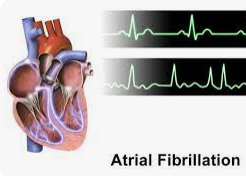Epidemio-clinical aspect of atrial fibrillation seen in three cardiology departments in Madagascar
Abstract
Introduction: Atrial fibrillation is the most common rhythm disorder. The main objective of this study is to describe the epidemiological and clinical aspect of atrial fibrillation in three cardiology departments in Antananarivo.aaaaaaaaaaaaaaaaa
Method: Multicenter cross-sectional study carried out in the Cardiology Unit, the Intensive Care Unit of Cardiology of the Joseph Raseta Befelatanana University Hospital Center and in the Internal Medicine and Cardiovascular Diseases Service of the Soavinandriana Hospital Center from January 1, 2020 to November 30, 2020aaaa
Results: Out of 1637 patients, 106 presented with atrial fibrillation, ie a prevalence of 6.47% with a mean age of 56 years. Permanent atrial fibrillation was the most common type (38.69%). The main risk factor associated with the development of atrial fibrillation was high blood pressure (51.00%). Among all patients: 66.98% had dilated left atrium and 21.11% had mitral stenosis. The main complication was heart failure (63.21%).
Conclusion: The epidemiological-clinical profile is dominated by the young age of our population; which is explained by the high prevalence of rheumatic valve disease in Madagascar as in other African countries.
Full text article
References
Benjamin EJ, Muntner P, Alonso A, Bittencourt MS, Callaway CW, Carson AP, et al. Heart disease and stroke Statistics-2019 update a report from the American Heart Association. Circulation. 2019;
Frick K, Klinzing S, Bühler PK, Unseld S, Greutmann M, Pfammatter T, et al. Cause rare de choc cardiogénique dans le cadre d’une insuffisance cardiaque à haut débit. In: Forum Médical Suisse. EMH Media; 2019. p. 811–814.
Mas J-L. Complications thromboemboliques de la fibrillation atriale. Arch Cardiovasc Dis Suppl. 2013;5(2):125–131.
Tejani AM, Musini V. Dabigatran et fibrillation auriculaire. Les conclusions de l’étude RE-LY ne suffisent pas. Médecine. 2012;8(3):106–109.
A Rakotonaivo, FHR Raveloson ,LR Ramiandrisoa, N, Rabearivony. Profil épidémiologique et clinique de la fibrillation auriculaire au service de Cardiologie du CHU-JRB, Madagascar. Jaccr Africa. 2020;4(1):171‑6.
Hindricks G, Potpara T, Dagres N, Arbelo E, Bax JJ, Blomström-Lundqvist C, et al. 2020 ESC Guidelines for the diagnosis and management of atrial fibrillation developed in collaboration with the European Association of Cardio-Thoracic Surgery (EACTS) The Task Force for the diagnosis and management of atrial fibrillation of the European Society of Cardiology (ESC) Developed with the special contribution of the European Heart Rhythm Association (EHRA) of the ESC. Eur Heart J. 2020;
Sliwa K, Carrington MJ, Klug E, Opie L, Lee G, Ball J, et al. Predisposing factors and incidence of newly diagnosed atrial fibrillation in an urban African community: insights from the Heart of Soweto Study. Heart Br Card Soc. déc 2010;96(23):1878‑82.
Ogunsua AA, Shaikh AY, Ahmed M, McManus DD. Atrial Fibrillation and Hypertension: Mechanistic, Epidemiologic, and Treatment Parallels. Methodist DeBakey Cardiovasc J. 2015;11(4):228‑34.
Gumprecht J, Domek M, Lip GY, Shantsila A. Invited review: hypertension and atrial fibrillation: epidemiology, pathophysiology, and implications for management. J Hum Hypertens. 2019;1–13.
Lane DA, Skjøth F, Lip GYH, Larsen TB, Kotecha D. Temporal Trends in Incidence, Prevalence, and Mortality of Atrial Fibrillation in Primary Care. J Am Heart Assoc [Internet]. 5 mai 2017 [cité 21 juin 2020];6(5). Disponible sur: https://www.ahajournals.org/doi/10.1161/JAHA.116.005155
Marcolino MS, Palhares DMF, Benjamin EJ, Ribeiro AL. Atrial fibrillation: prevalence in a large database of primary care patients in Brazil. Eur Eur Pacing Arrhythm Card Electrophysiol J Work Groups Card Pacing Arrhythm Card Cell Electrophysiol Eur Soc Cardiol. déc 2015;17(12):1787‑90.
Sztajzel J. Fibrillation auriculaire: Quoi de neuf? Rev Med Suisse. 2000;4:20558.
Lugero C, Kibirige D, Kayima J, Mondo CK, Freers J. Atrial fibrillation among the black population in a Ugandan tertiary hospital. Int J Gen Med. 2016;9:191‑8.
Proietti M, Marra AM, Tassone EJ, De Vuono S, Corrao S, Gobbi P, et al. Frequency of Left Ventricular Hypertrophy in Non-Valvular Atrial Fibrillation. Am J Cardiol. 15 sept 2015;116(6):877‑82.
Healey JS, Connolly SJ. Atrial fibrillation: hypertension as a causative agent, risk factor for complications, and potential therapeutic target. Am J Cardiol. mai 2003;91(10):9‑14.
